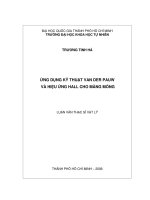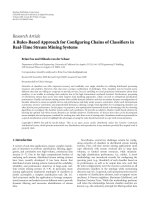ludwig mies van der rohen
Bạn đang xem bản rút gọn của tài liệu. Xem và tải ngay bản đầy đủ của tài liệu tại đây (37.77 KB, 2 trang )
Ludwig Mies Van der Rohen was born in Aachen, Germany, in 1886, and lived all the way
through to 1969. He was considered a pioneer of glass skyscrapers. He also liked to design
tubular-steel furniture, like his famous "Barcelona chair", used in the Barcelona Pavilion, another
of his great works. He became a professor of architecture in Chicago, where he designed two glass
apartment towers on Lake Shore Drive, around 1956.
His greatest work is considered to be the Barcelona Pavilion, which in its original form was only a
temporary building, meant for the Barcelona World fair. When the fair ended, it was supposedly
shipped back to Germany, but lost in transit. Although many people praise it as the "greatest work
of Modern Architecture", most of them have only seen it in pictures or photographs(although one
architecture firm reproduced the pavilion, in cheaper materials, for use as their office !). But a
peculiar thing about this building is that when it was introduced in the Barcelona world fair, it did
not contain exhibits, it only contained chairs, tables and stools designed by Rohe. It also contained
a statue, called the "Kolbe", near a small pool. . He intended the structure to act as the exhibit
itself, representing the "new thinking in Germany under the Weimar Republic"(Evans, 57). Most
people didn't understand it. J
What made it so unique ? Mies realized that the wall could be independent of the weight of the
roof, so he designed 8 colums that would carry the weight of the roof, but the walls did carry some
of the weight. This is where the pavilion received some criticism, with people saying that he "get
rid of those damned little posts interfering with his lovely design"(Evans, 58).
The other element of the pavilion is the Kolbe, which seems was put there because Mies was
anxious to present his work. It was created by Lehmbruck.(Speyer, 54)
The Kolbe, designed by Lehmbruck
Mies was considered a very simple person, whose philosophy was "not to design Buildings, but to
develop them". In his own words :"I want things to be simple. Mind you: a simple person is not a
simpleton.
I like simplicity, probably because I like clarity, not because of cheapness or something like that.
We never think of reducing cost when we work." Most people consider that his buildings owed
more to technology and financial resources than his creativity. But here's an article that(I think)
proves this wrong :
From Peter Carter's, "Mies van der Rohe, An Appreciation on the Occasion, This Month, of His
75th Birthday," Architectural Design 31 (March 1961):97(found in the internet at
)
"Fuchs asked Mies if he would comment on a design for the monument . Mies did, and after
some time he observed that the monument's neo-classical design would be expensive to construct
and appeared antithetic to the two communists' beliefs. Fuchs agreed. So Mies designed a thick
wall and constructed it of bricks which had been fired too long or at too high a temperature.
Because these bricks were rough and irregular, they cost nothing only the effort of carting them
away."
"We must remember," he wrote, "that everything depends upon how we use a material, not on the
material itself."
In 1960, Mies was awarded the American institute of Architects' Gold medal for distinguished
service to the profession. A few years before his death, he spoke these words to his students :
(From "Ludwig Mies van der Rohe, [Acceptance Speech upon receiving the Gold Medal of the
American Institute of Architects,] Journal of the AmericanArchitects 33" (June 1965): 90-91,
found in the internet)
"We are not at the end, but at the beginning of an epoch; an epoch which will be guided by a new
spirit, which will be driven by new forces, new technological, sociological and economic forces,
and which will have new tools and new materials. For this reason we will have a new
architecture."









